Constellation: Aries, Cassiopeia, Corona Borealis, Cygnus, Delphinus, Perseus, Sagitta, Scorpius, Scutum, Triangulum, Ursa Major
Asterism: Coathanger, Kemble’s Cascade, Keystone of Hercules, Square of Pegasus, Summer Triangle / DAVe
Planets: Jupiter, Saturn
Stars: Albireo, Altair, Antares, Capella, Deneb, Polaris, Spica, Vega
Messier Objects: M4, M7 (Ptolemy’s Cluster), M8 (Lagoon Nebula), M11 (Wild Duck Cluster), M13 (Hercules Cluster), M20 (Trifid Nebula), M21, M22 (NGC 6656), M31 (Andromeda Galaxy), M69 (NGC 6637)
Meteor
Satellites (4; one was the ISS)
Couldn't find: Perseus (hidden by a tree and house), M17, M23, M54, M70
Location: SCO
Date: 2017-07-23/24
Time: 8:00 PM - 2:30 AM
Instrument: Visual + Binoculars 10x30 IS
Transparency: Excellent (5)
Seeing: Excellent (5)
Temperature: 10º C
New Moon. No wind or cloud.
Helped Jerry get set up for his astroimaging then sat and watched as the stars made their appearance in the night sky. New Moon today.
Saturn
Time: 9:50 PM
Instrument: Binoculars
Saturn was located near the Teapot. Easily found due to its visual brightness. Using binoculars, I could determine it wasn't a "round" object but couldn't see the rings at this level of magnification. |
Jupiter
Time: 9:55 PM
Instrument: Binoculars
I was looking for Spica (which I did find) but also noted Jupiter was once more near Virgo. |
Summer Triangle / DAVe
Time: 9:50 PM - 10:05 PM
Instrument: Visual
Three stars the asterism exposed themselves over a 10-minute period - Deneb, Altair, Vega.
|
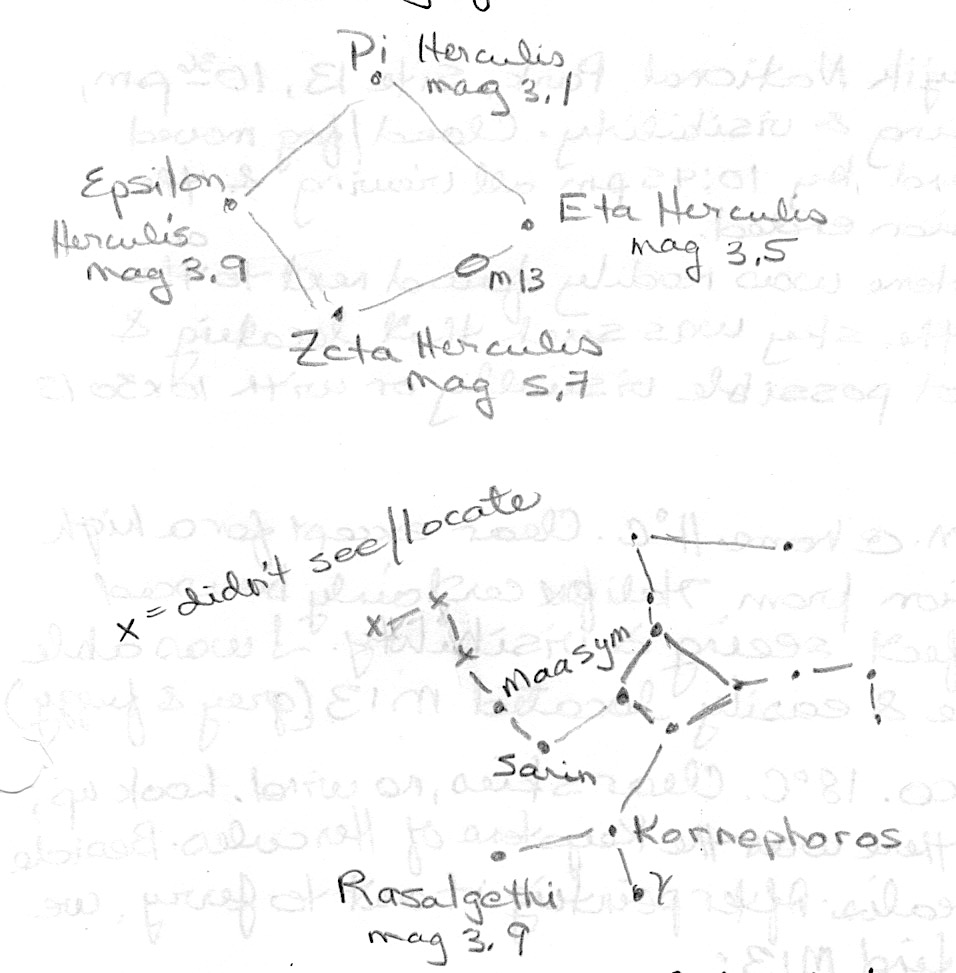
|
Keystone of Hercule & M13 (Hercules Globular Cluster)
Time: 10:17 PM + 12:05 AM
Instrument: Visual + Binoculars
S&T Chart Ref: 52, 54
I viewed the Keystone of Hercules that appeared overhead. M13 could be seen naked eye between η Herculis and ζ Herculis.
I used the binoculars to confirm what I was seeing visually. I also viewed it again with binoculars after midnight when I was able to point out all 4 arms of Hercules to Jerry. I was amazed at how easy it was to find all the stars in the arms.
|
|
Corona Borealis
Time: 9:56 PM - 2:30 AM
Instrument: Binoculars
S&T Chart Ref: 53, 55
I could easily identify all the stars in the Corona. Although the initial sighting was at 9:56 PM, it was seen numerous times throughout this observing session.
Ursa Major
Time: 9:56 PM
Instrument: Binoculars
S&T Chart Ref: 31, 32, 33, 43, F
Easily made out all 7 stars of the Dipper plus Polaris naked eye. No binoculars.
|
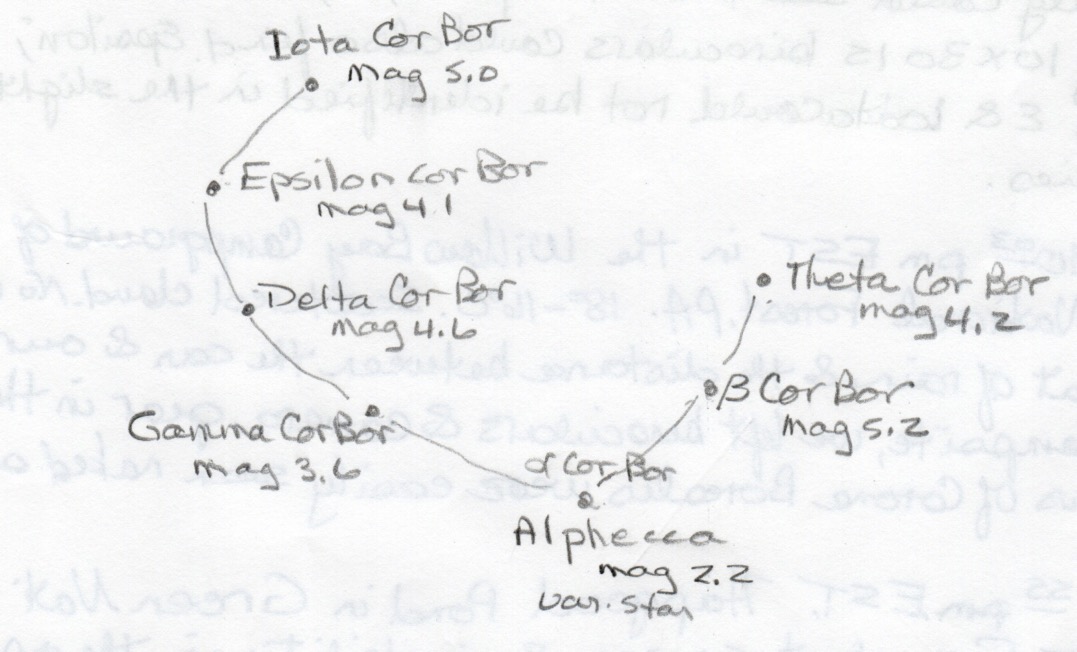 |
Cassiopeia
Time: 10:12 PM + 12:00 midnight
Instrument: Binoculars
S&T Chart Ref: 1, 3, 72
All 5 stars were readily seen naked eye. Attempted to use binoculars but the multitude of stars in my FOV confused me. When I easily found this constellation at midnight, I decided to try to find Kemble's Cascade. |
Kemble's Cascade
Time: 10:00 PM + 12 midnight
Instrument: Binoculars
S&T Chart Ref: 11, 13
Could find all of Kemble's Cascade at 12 midnight but could not find it around 10 PM when looking at Cassiopeia. A beautiful tumbling of stars that ended in the hockey stick. |
|
M4 (NGC 6121)
Time: 10:15 PM + 10:34 PM + 12:08 AM
Instrument: Binoculars
S&T Chart Ref: 56, 58
Viewed Antares specifically at 10:15 PM and 10:34 PM naked eye. Used my binoculars to
locate M4 at 12:08 AM. Again, the grey fuzzy was better seen with averted vision - both
visually and with binoculars.
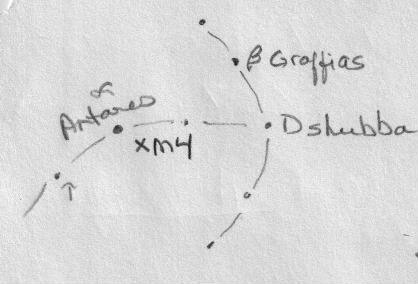
|
Meteor
Time: 10:30 PM
Instrument: Visual
Travelled from Cepheus towards Cygnus.
M7 (Ptolemy's Cluster, NGC 6475)
Time: 10:40 PM
Instrument: Binoculars 10x30 IS
S&T Chart Ref: 56, 67, 69, I
Teapot was high for most of this viewing session. I followed the line from Ascella to Kaus Australis then followed the extension of that line out the same distance to M7. The open cluster was very visible, the brighter stars forming a squarish ring within the nebulosity and had numerous less bright stars around them. Not as showy as the Pleiades - but close!
|
Scorpius
Time: 10:34 PM
Instrument: Visual + Binoculars
S&T Chart Ref: 56, 58, J
Scorpius was mostly above the tree tops but η, θ and ξ were below the treeline. I noticed the 'stinger' was quite bright so used my binoculars to look at the 2 stars - Shaula and Lesath. I wasn't disappointed. Both quite bright in a single FOV. |
M69
Time: 10:43 PM
Instrument: Visual
S&T Chart Ref: 67, 69
Located Kaus Australis and the adjacent sides of the Teapot. Put Australis in my lower right FOV and looked towards Nunki but just above the Ascella-Australis line. Found it with averted vision. It was a dark grey small fuzzy object.
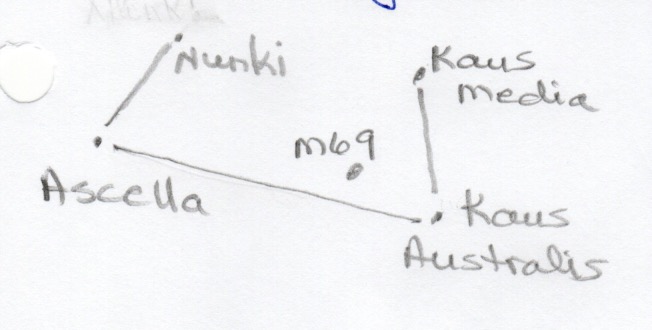
|
Cygnus
Time: 10:52 PM + 12:35 AM
Instrument: Visual + Binoculars
S&T Chart Ref: 63, 73, H
Deneb had come out earlier in the evening; had to wait to visualize the stars in Cygnus to find Albireo, Sadr and η Cygni when the sky was darker and the Milky Way was just starting to show up. Could easily see the wing stars from ζ to ι. The blue-gold of the double star Albireo could be seen but seemed to "twinkle"; could not discern between the 2 stars with the binoculars. Saw Cygnus visually again in the early morning - quite evident in the Milky Way. |
Coathanger / Collinder 399 / Brocchi's Cluster
Time: 10:52 PM
Instrument: Binoculars
S&T Chart Ref: 65
Just put my binoculars to my eyes after locating Albireo and guesstimated where it might be located - et voilá! Just like an old friend. I love finding this asterism! All 10 stars were very clearly seen. |
|
Delphinus
Time: 10:52 PM + 12:12 AM
Instrument: Visual
S&T Chart Ref: 64
Found Delphinus visually twice while looking for Sagitta. All 5 stars, although not exceedingly bright, could be seen above Aquila. Art Cole and I had a discussion about the two small constellations.
Satellite (ISS)
Time: 11:05 PM
Instrument: Visual + Binoculars
Noticed a high speed bright light light going from Boötes towards the Square of Pegasus. Its speed was a little too fast for a plane and there were no red-green blinking lights. Binoculars confirmed it was not a plane. Art Cole confirmed it was the ISS. Very big! Very bright! VERY fast!
|
Satellite
Time: 11:20 PM
Instrument: Visual
Travelled from mid Boötes and disappeared before reaching Alkaid in UMa.
Satellite
Time: 12:07 PM
Instrument: Visual
Travelled from bottom of Ophiuchus across the top of the Teapot. Quite bright. Lost visual in the trees.
Sagitta
Time: 12:12 AM
Instrument: Visual
S&T Chart Ref: 64
Found the 4 stars of Sagitta above Altair. It formed a triangle with Delphinus and Aquila. The stars, like those in Delphinus were not very bright - had to look at the stars for a few seconds to out α and ß, whereas γ and δ were more readily found.
|
|
M31 (Andromeda Galaxy)
Time: 12:15 AM + 12:30 AM
Instrument: Visual + Binoculars
S&T Chart Ref: 3, 72
Cassiopeia, the Square of Pegasus and Andromeda constellation were in an area of the sky high enough above the trees behind the Storage Room that M31 could be found - visually and with my binoculars. Visually, it was a faint fuzzy. With binoculars, it could be seen with direct vision but better viewed with averted. It was viewed twice in this session. Bright core and nebulous oblong quite large compared to the core.
|
Meteor
Time: 12:25 AM
Instrument: Visual
Travelled from Camelopardalis and disappeared at Kemble's Cascade.
Pegasus
Time: 12:30 AM
Instrument: Visual
S&T Chart Ref: 74, 75
Able to see all 4 stars in the Square of Pegasus (Alpheratz, Algenib, Mark, Scheat) and the nearby Andromeda. However, the legs were hidden by the trees.
|
|
Perseus
Time: 12:30 AM
Instrument: Visual
S&T Chart Ref: 2, 13
I saw what to my eyes was an arch of stars below Cassiopeia which led me to believe these were not stars in that constellation. I had drawn an imaginary line from τ to ι, then to κ, Algol and ρ. I then continued another arch through ο, Atik, and Menkib. Using SkySafariPro, I also discovered that it was Perseus! Knowing that, the only stars I couldn't find visually were γ, b, φ and θ.
|
|
Capella (in Auriga)
Time: 12:53 AM
Instrument: Visual
S&T Chart Ref: 12
I found Capella just above the horizon while standing between the warming and storage sheds. It was very bright! I had to use SkySafariPro to determine what I was seeing. No other stars could be seen as they were below the horizon.
Aries
Time: 1:05 AM
Instrument: Binoculars
S&T Chart Ref: 4
Thought I had found it earlier this month but quickly realized I had been looking at the wrong section of sky. Did some homework before coming to SCO to ascertain exactly where to look for this almost straight line constellation. Having found Triangulum, Aries was found below it towards to the horizon. I could readily find 41, α and ß but had difficulty finding γ, and not sure if in fact I did find γ. Thrilled to have found this constellation at last!
Triangulum
Time: 1:05 AM
Instrument: Visual + Binoculars 10x30 IS
S&T Chart Ref: 2, 4
First seen just after viewing M31. Took greater care to observe it naked eyed also attempted to view it with binoculars. Stars were easily seen against the dark sky.
|
M8 (Lagoon Nebula)
Time: 1:05 AM
Instrument: Binoculars
S&T Chart Ref: 67, 69, I
Easily able to see the nebula with my binoculars. The nebula was quite bright as was the line of 5 stars in it (or maybe below it?).
M20 (Trifid Nebula)
Time: 1:05 AM
Instrument: Binoculars
S&T Chart Ref: 67, 69, I
M20 was in the same FOV as M8. Very bright stars with greyish nebulosity.
M21
Time: 1:01 AM + 1:20 AM
Instrument: Binoculars
S&T Chart Ref: 67, 69, I
Moved my binoculars up to the left about 45º from M8 to find M21. Another grey fuzzy.
M22 (NGC 6656)
Time: 1:12 AM
Instrument: Binoculars
S&T Chart Ref: 67, 69, I
Found Kaus Borealis and put it at 5 o'clock in my binocular FOV. Near the centre of my view was a "Y" shape of stars (identified later as 24 Sgr, 25 Sgr and HD170978) and just past it was M22. Another grey fuzzy.
|
|
M11 (Wild Duck Cluster)
Time: 1:28 AM + 1:47 AM
Instrument: Visual + Binoculars
S&T Chart Ref: 67
Thanks to Dave Chapman, I remembered how to find M11. I first looked for a semi-circle of stars in the Milky Way just above the Teapot. The stars in this formation were very bright. I identified them as Globular Cluster 6712, δ Scuti and ε Scuti. I knew the "golf club" was part of the semi-circle and that M11 was the "golf ball" adjacent to it. I stared naked eye at the δ Scuti and ε Scuti section of the semi-circle, put my binoculars to my eyes and there it was! The open cluster was a perfectly round, grey fuzzy with a dark centre.
I was so happy to find it the first time that I found it again a few minutes later. Just had to see it a second time before we left SCO.
|
Scutum
Time: 1:47 AM
Instrument: Visual
S&T Chart Ref: 67
This constellation escaped me until I could find the 'golf club' of stars adjacent to M11. Started by finding the set-circle of stars that I had predetermined were the Globular Cluster 6712, δ Scuti and ε Scuti. I also noted Aquila and using the semi-circle as landmarks found the 4 stars. This constellation that had eluded me for the past year or more was finally identified. Landmarks for orientation to location was a great help.
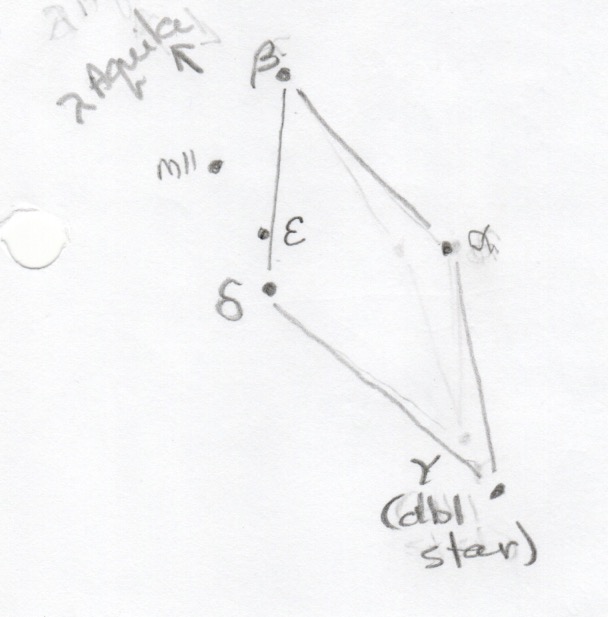
|




